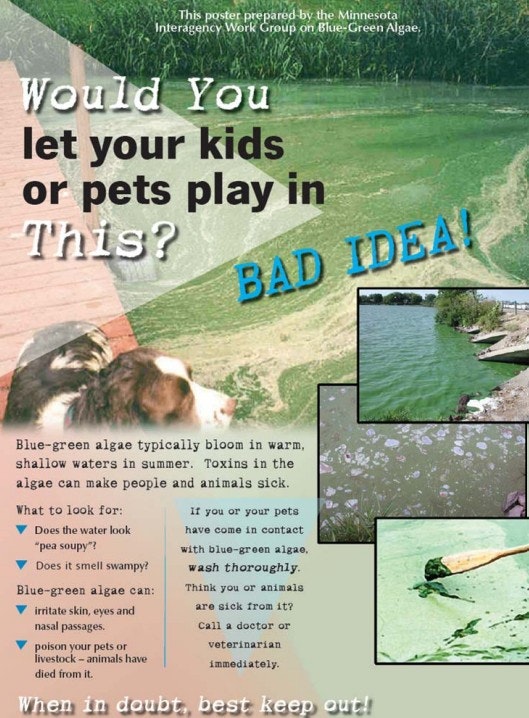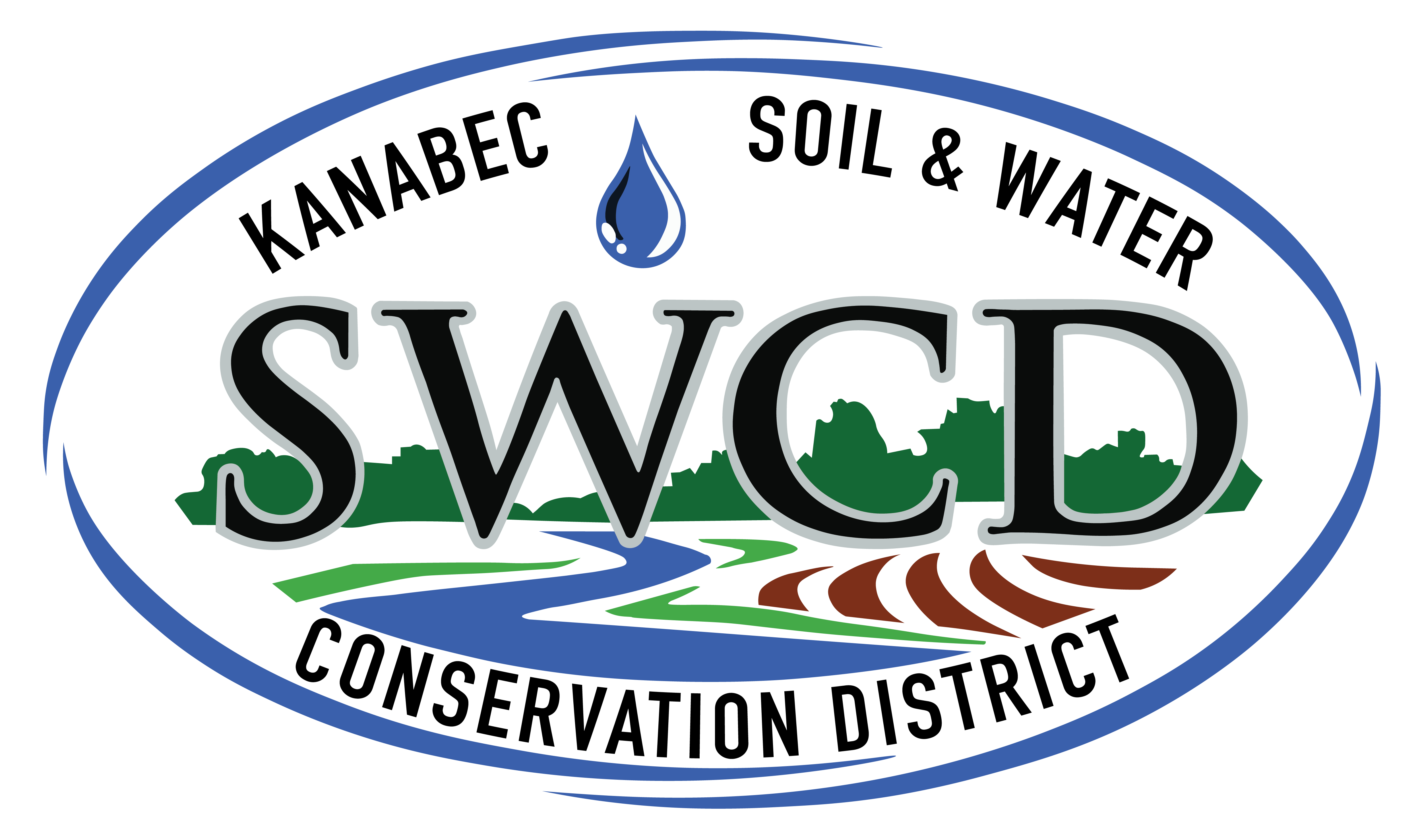Harmful Algal Blooms (HABs) and Blue-Green Algae in Minnesota Waters
Blue-green algae, also known as cyanobacteria, are one of several types of algae naturally found in Minnesota lakes and rivers. While not always harmful, under the right conditions, blue-green algae can grow excessively and release toxins that pose risks to both humans and animals.

Why Are Blue-Green Algae So Common?
Blue-green algae thrive in specific environmental conditions - many of which are frequently found in Minnesota’s shallow lakes:
- High nutrient levels, especially phosphorus
- Warm water temperatures (above 75-80°F)
- Calm, sunny weather
- Shallow depth and slow water movement
These algae have a competitive edge over other species:
- They can float and form surface scums.
- They can fix nitrogen from the atmosphere when water nitrogen is low.
- They are resistant to being eaten by zooplankton.
What Do Blue-Green Blooms Look Like?
Blooms can vary in appearance - colors may include green, blue-green, teal, white, or even brown. The water may look like pea soup, spilled paint, or have mats and scums floating on the surface.
Toxins Produced by Blue-Green Algae
Some blue-green algae species produce potent toxins that can impact humans and animals. There are three main types:
- Hepatotoxins - affect the liver (e.g., microcystin)
- Neurotoxins - affect the nervous system
- Dermatoxins - cause skin irritation
These toxins can be present even when blooms are not visibly severe.
Lakeline Article - Microcystin in Minnesota Lakes [PDF]How People and Animals Can Be Exposed
Recreational exposure is the most common concern in Minnesota. People can be affected through:
-
Ingestion: swallowing lake water while swimming, tubing, or water skiing. See below for info on fish.
- Fish: Eating fish from algae-laden waters
- Toxins from algae can accumulate in the entrails (guts) of fish and occasionally in the muscle (fillet). Levels in fish depend upon the severity of the bloom in the area where the fish are caught.
- In general, fish that are caught in areas of a waterbody where major blue-green algae blooms are occurring may be safe to eat, as long as the guts are discarded. However, it's uncertain how much algae toxin can accumulate in fillets, so anglers may want to wait a week or two after algae blooms are over before fishing and eating fish from waters where a bloom is occurring.
- Fish: Eating fish from algae-laden waters
- Inhalation: breathing aerosolized toxins during boating or irrigation
- Skin contact: while swimming, wading, or water skiing, or tubing
Pets, especially dogs, are particularly vulnerable when they drink contaminated water or lick algae off their fur.
Blue-Green Algae and Dog Safety [PDF]Minnesota’s Experience with HABs
Blue-green algae have long been present in Minnesota, but concerns have grown in recent decades:
Late 1800s
- First documented accounts of algal toxicity in Minnesota waters.
1990s
- Growing concern both statewide and globally about harmful algal blooms and their potential impacts on health and ecosystems.
- Increase in bloom reports and anecdotal evidence of health effects.
2004
- Three confirmed dog deaths linked to algal toxins in Fish Lake (Mora) and Lake Benton (Lincoln County).
- These incidents raised awareness of the severity of the issue and prompted increased public and agency attention.
2005
- The Minnesota Pollution Control Agency (MPCA) formally joined with the Minnesota Department of Natural Resources (MDNR), Minnesota Department of Health (MDH), and the Minnesota Veterinary Medical Association (MVMA) to establish the Minnesota Blue-Green Algal Toxicity Workgroup.
- Goal: Coordinate research, education, and response to harmful algal blooms.
2006
- MPCA conducted a systematic study of microcystin (MC) concentrations in 12 eutrophic lakes located in Blue Earth and McLeod counties.
- Study helped quantify toxin levels under various bloom conditions.
2007
- Five additional dog deaths suspected to be caused by blue-green algae exposure.
- Minnesota participated in a national lake study, measuring microcystin in:
- 50 randomly selected lakes
- 35 additional lakes in southern Minnesota
2009
- MPCA and partners published findings on their cumulative research to date.
- Shared information on prevalence, conditions favoring toxin production, and strategies for monitoring.
2012
- Minnesota participated in another national study assessing harmful algal blooms, this time analyzing:
- 150 randomly selected lakes statewide for microcystin and related data.
2014
- Published a comprehensive article summarizing all Minnesota-based microcystin data collected to that point.
- Three more reported dog deaths suspected to be linked to toxic blooms.
2015
- Three additional dog deaths were reported.
- One human health incident linked to possible exposure to algal toxins also reported.
What We’ve Learned
- Blue-green algae occur in all Minnesota lakes, but not all blooms are toxic.
- Filamentous algae is sometimes confused with blue-green algae, which is a type of cyanobacteria. Both float on the surface of lakes and ponds, but there is an easy way to tell them apart:
- Severe blooms are more likely in warm, nutrient-rich, and calm lakes.
- High toxin levels (e.g., microcystin) can occur any time during the open water season - not just in late summer.
- Toxin exposure risks rise with bloom intensity.
- Most drinking water supplies are well protected, with treatment removing toxins from finished water.
- Animal deaths have occurred as early as June and as late as October.
Public Health Guidance
Minnesota does not currently have a human recreational health standard for blue-green algae toxins, but the Minnesota Department of Health (MDH) has developed drinking water guidance for microcystin. The MPCA, MDH, DNR, and the Minnesota Veterinary Medical Association continue to monitor, respond, and educate the public.
Many algal bloom special interest groups focus specifically on theses issues:
- North Central Region Water Network's Algal Bloom Action Team
- The Great Lakes Commission's HABs Collaborative
- EPA's CyAN mobile app provides access to algae bloom satellite data for more than 2,000 of the largest lakes and reservoirs in the country.
Challenges We Face
- Rapid onset of illness in dogs and lack of quick diagnostic tools
- Blooms can disappear quickly, complicating sampling and response
- Limited statewide testing resources for rare or fast-degrading toxins
- Some animal deaths occurred even without visible severe blooms
- Balancing public communication to raise awareness without unnecessary alarm
What You Can Do
- Avoid swimming or allowing pets in water that is discolored, scummy, or smells bad.
- Rinse off with clean water after lake activities.
- Report suspected blooms or animal illnesses to the MPCA.
- Reduce nutrient runoff from your property (limit fertilizer use, maintain shoreline vegetation, fix erosion).
Reporting blooms
Algae blooms are a normal part of lake ecology. If you observe a large or very dense bloom and would like to report it, please use the bloomWatch app.
Reporting fish kills
If you see multiple dead fish in a lake or river (or runoff or a spill entering waters), call the Minnesota Duty Officer at 800-422-0798. Calls are answered 24 hours a day, 365 days a year. If there is an immediate threat to life or property, call 911 first.




